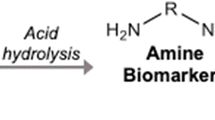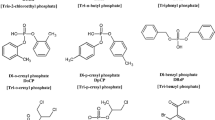Summary
To identify the method of choice for analysis of urine for 2,5-hexanedione (2,5-HD) as an indicator of occupational exposure to n-hexane, the end-of-shift urine samples of 36 n-hexane exposed male workers and 30 non-exposed male workers were analyzed for 2,5-HD under three conditions of hydrolysis, i.e. enzymic hydrolysis at pH 4.8, acid hydrolysis at pH 0.5, and without hydrolysis. The 2,5-HD concentrations thus determined were examined for correlation with 8-h, time-weighted average exposure concentrations of n-hexane measured by diffusive sampling. The regression analysis showed that the 2,5-HD concentrations without any hydrolysis correlated best with the intensity of exposure to n-hexane. No 2,5-HD was detected in the urine of the non-exposed subjects under the analytical conditions with no hydrolysis. Thus, the analysis without hydrolysis was considered to be the method of choice from the viewpoint of simplicity in analytical procedures, sensitive separation of the exposed from the non-exposed, and quantitative increase in the amount of 2,5-HD after n-hexane exposure.
Similar content being viewed by others
References
Ahonen I, Schimberg RW (1988) 2,5-Hexanedione excretion after occupational exposure to n-hexane. Br J Ind Med 45:133–136
American Conference of Governmental Industrial Hygienists (1989) Threshold limit values and biological exposure indices for 1989–1990, ACGIH, Cincinnati, Ohio, USA, p 25
De Rose E, Bartolucci GB, God GP, Perbellini L, Brugnone F (1987) Use of passive dosimeters in the monitoring of occupational exposure to solvents. In: Berlin A, Brown RH, Saunders KJ (eds) Diffusive sampling, an alternative approach to workplace air monitoring. Royal Society of Chemistry, London, pp 82–84
Deutsche Forschungsgemeinschaft (1989) Maximale Arbeitsplatzkonzentrationen und Biologische Arbeitsstofftoleranzwerte 1989. VCH Verlagsgesellschaft, Weinheim, FRG, p 36
Fedtke N, Bolt HM (1986a) Detection of 2,5-hexanedione in the urine of persons not exposed to n-hexane. Int Arch Occup Environ Health 57:143–148
Fedtke N, Bolt HM (1986b) Methodological investigations on the determinations of n-hexane metabolites in urine. Int Arch Occup Environ Health 57:149–158
Fedtke N, Bolt HM (1987a) 4,5-Dihydroxy-2-hexanone; a new metabolite of n-hexane and of 2,5-hexanedione in rat urine. Biomed Environ Mass Spectrom 14:563–572
Fedtke N, Bolt HM (1987b) The relevance of 4,5-dihydroxy-2-hexanone in the excretion kinetics of n-hexane metabolites in rat and man. Arch Toxicol 61:131–137
Hirayama T, Ikeda M (1979) Applicability of carbon felt to the dosimetry of solvent vapor mixture. Am Ind Hyg Ass J 40:1091–1096
Ikeda M, Kumai M, Aksoy M (1984) Application of carbon felt dosimetry to field studies distant from analytical laboratory. Ind Health 22:53–58
Inoue T, Takeuchi Y, Takeuchi S, Yamada S, Suzuki H, Matsushita T, Miyagaki H, Maeda K, Matsumoto T (1970) A health survey on vinyl sandal manufacturers with high incidence of “n-hexane” intoxication. Jpn J Ind Health 12:73–84 [Japanese with English Abstr]
Inoue T, Takeuchi Y, Hisanaga N, Ono Y, Iwata M, Ogata M, Saito K, Sakurai H, Hara I, Matsushita T, Ikeda M (1983) A nationwide survey on organic solvent components in various solvent products: Part I. Homogeneous products such as thinners, degreasers and reagents. Ind Health 21:175–183
Iwata M, Takeuchi Y, Hisanaga N, Ono Y (1983a) A study on biological monitoring of n-hexane exposure. Int Arch Occup Environ Health 51:253–260
Iwata M, Takeuchi Y, Hisanaga N, Ono Y (1983b) Changes of n-hexane metabolites in urine of rats exposed to various concentrations of n-hexane and its mixture with toluene or MEK. Int Arch Occup Environ Health 53:1–8
Jackson S (1966) Creatinine in urine as an index of urinary excretion rate. Health Phys 12:843–850
Japan Association of Industrial Health (1989) Recommended occupational exposure limits (Japanese). Jpn J Ind Health 31:257–277
Kasahara M, Ikeda M (1987) Spontaneous desorption of organic solvents from carbon cloth. Ind Health 25:73–81
Koizumi A, Ikeda M (1981) A servomechanism for vapor concentration control in experimental exposure chambers. Am Ind Hyg Ass J 42:417–425
Kumai M, Koizumi A, Saito K, Sakurai H, Inoue T, Takeuchi Y, Hara I, Ogata M, Matsushita T, Ikeda M (1983) A nationwide survey on organic solvent components in various solvent products: Part II. Heterogeneous products such as paints, inks and adhesives. Ind Health 21:185–197
Mutti A, Falzoi M, Lucertini S, Arfini G, Zignani M, Lombardi S, Francini I (1984) n-Hexane metabolism in occupationally exposed workers. Br J Ind Med 4:533–538
Ono Y, Takeuchi Y, Hisanaga N, Iwata M, Kitoh J, Sugiura Y (1982) Neurotoxicity of petroleum benzine compared with n-hexane. Int Arch Occup Environ Health 50:219–229
Perbellini L, Brugnone F, Pastorello G, Grigolini L (1979) Urinary excretion of n-hexane metabolites in rats and humans. Int Arch Occup Environ Health 42:349–354
Perbellini L, Brugnone F, Pavan I (1980) Identification of the metabolites of n-hexane, cyclohexane, and their isomers in men's urine. Toxicol Appl Pharmacol 53:220–229
Perbellini L, Brugnone F, Faggionato G (1981) Urinary excretion of the metabolites of n-hexane and its isomers during occupational exposure. Br J Ind Med 38:20–26
Rainsford SG, Lloyd Davies TA (1965) Urinary excretion of phenol by men exposed to vapour of benzene; a screening test. Br J Ind Med 22:21–26
Wang J-D, Chang Y-C, Kao K-P, Huang C-C, Lin C-C, Yeh W-Y (1986) An outbreak of n-hexane induced polyneuropathy among press proofing workers in Taipei. Am J Ind Med 10:111–118
Author information
Authors and Affiliations
Rights and permissions
About this article
Cite this article
Kawai, T., Mizunuma, K., Yasugi, T. et al. The method of choice for the determination of 2,5-hexanedione as an indicator of occupational exposure to n-hexane. Int. Arch Occup Environ Heath 62, 403–408 (1990). https://doi.org/10.1007/BF00381372
Received:
Accepted:
Issue Date:
DOI: https://doi.org/10.1007/BF00381372




